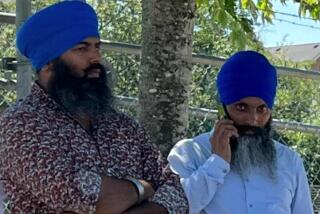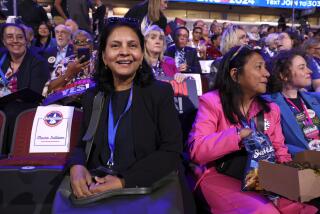Maharajah Takes a Turn in Washington
- Share via
NEW DELHI, India — When Karan Singh, India’s 58-year-old ambassador to the United States, prepares to deliver an especially important speech about, say, the sources of Indian philosophy or the myriad interpretations of the ancient Vedic texts, he finds it helpful to first blast a little rock ‘n’ roll.
“I love rock music!” he explodes in his rich tenor, a voice that laughs and lectures with kingly confidence. “I’m an absolute fan of rock music. I like Dire Straits, I like the Pet Shop Boys. I like Whitney Houston. I like Stevie Wonder. I can listen to them for hours and hours and hours! Prince, Michael Jackson--the lot!”
He leans forward on the desk in his opulent study, hands clasped in royal manner, his green cap slightly tilted, and he is nearly frantic with delight. Fifty years ago, Karan Singh was heir-apparent to the throne of the paradisiacal princely state of Kashmir in northern India.
Two full-scale wars and a thousand skirmishes have been fought in Kashmir since Singh was a boy prince but the strife has left no imprint on his face. He seems a fount of enthusiasm.
There can be little doubt that when Singh and his wife, Princess Yasho Rajya Lakshmi, a Nepalese philosopher, settle into the Indian ambassador’s residence in Washington this month, the presence and image of India in the U.S. capital will undergo a dramatic change.
In the beginning, at least, Singh expects to be engulfed by Americans’ fascination with his status as a “real live maharajah,” as he puts it with a tolerant but weary laugh. And there will be plenty to attract such fascination: an extensive private art collection drawn from India and the West; stunning statues and carvings from the pantheon of Hindu gods; a collection of family jewels recently valued at about $2.5 million by an Indian judge.
“This whole maharajah syndrome is OK, as long as it’s within reasonable limits,” he says.
When he travels to the United States and Europe, he is often asked if he has ridden an elephant, which he has not. He is asked about his wedding, at which, according to Ann Morrow’s chronicle of the maharajahs, “Highness,” his bride was carried by eight servants on a silver platform while eight maidens in red saris waved white horsetail brushes before her. There are endless questions, too, about his dreamlike childhood in the palace overlooking Dal Lake, wherein the blue and white peaks of the Himalayas are still reflected.
Singh notes with bemusement that while he, his wife and his only daughter, also a philosophy teacher, have carved out identities partly separate from his princely inheritance, his two sons yearn for the lost privileges of the crown.
While Singh speaks in his study, one son toils beyond the window in the torrid sun, struggling with a household staffer to clean and polish his Mercedes sedan. “The boys, oddly enough, seem to be some kind of a throwback,” he says with a booming laugh. “Maybe it’s because they subconsciously resent the fact that they never would get to be maharajah. They’re good boys, but sometimes I get a little astonished at their attitudes.”
As for himself, Singh says he has tried to find a middle ground. “I don’t deny that I was a maharajah, but I don’t want to be dismissed as some sort of a freak. I’m a person in my own right. I’ve written, I travel, I speak. I’ve got some ideas. I’d much rather be judged on those.”
But it seems clear that Singh could not escape from his identity as a maharajah even if he wanted to. The princely state over which he was born to rule ceased to exist more than 20 years ago. When he travels to his former domain today, however, he still finds there is “a good deal of regard. . . . Wherever one goes, they greet me with great affection. It’s very heartening in this day and age.”
The story of the Singh dynasty begins more than 100 years ago, when Kashmir was a feudal kingdom ostensibly ruled by its local maharajah, who claimed legitimacy from his people but whose power depended on the patronage of the British Raj. The British used Kashmir and hundreds of other princely states as political surrogates to consolidate their control of India. Singh’s great-grandfather was established on the Kashmir throne with British support; his descendants remained friendly to the empire until its end.
When the end came in 1947, British India was divided along religious lines in a bloody partition that created the modern Moslem nation of Pakistan and the Hindu-dominated nation of India. Maharajahs of the princely states were pressured to accede to one country or the other. In Kashmir, this was the problem: Hari Singh, a devoted Hindu, then was Kashmir’s maharajah; his son, Karan Singh, then was a ruler-in-waiting. But most of their subjects were Moslems.
In the end, the Singhs opted for India, a decision that resulted in a partition that favored India and which Pakistan still rejects. Thousands of troops on both sides have died fighting over the question. Kashmir remains a militarized, politically volatile region.
Perhaps, Singh speculates, he remains so ebullient and optimistic today because at some of the climactic moments of Kashmir’s tragedy, he was in a hospital bed in Manhattan, where he had been sent by his father to recover from a hip problem that kept him flat on his back in the same room for 10 1/2 months. “I was able to absorb a lot of America. I watched television.”
When he had learned to walk again, he returned to Kashmir, where the fighting had subsided but a long political intrigue had just begun. Backed by Indian Prime Minister Nehru, Singh’s father appointed his 18-year-old son regent of Kashmir; for more than a decade, Singh headed Kashmir in both elected and appointed posts.
When Nehru died and Indira Gandhi succeeded him, Singh was persuaded to join the central government. At 36, he became the youngest cabinet minister in India’s short history, assigned to manage the Ministry of Tourism and Civil Aviation, a potentially less hefty job that he tackled earnestly and for which New Delhi intellectuals and former government officials give him solid marks for his devotion.
He also proved to be something of a survivor in a country where the politics of personal favoritism are particularly volatile. But finally, he left parliament and devoted himself to religious and philosophical writing and lectures.
The imperial exotica of the British Raj, of which Singh himself is a living example, and the grinding poverty of the country’s peasant masses remain the popular images of India in the United States. The trouble is that the India that Singh wants to celebrate--the country that has built and maintained democratic institutions and eradicated widespread famine since it achieved independence--remains essentially a negative proposition. That is to say, what is stunning about India is less what it has accomplished than what it has avoided.
Still, as seismic shifts occur on the international scene--where Mikhail Gorbachev has pulled the moorings from under the Soviet Union, India’s most important ally, and is building bridges to China, India’s most daunting adversary other than Pakistan--India’s leaders want respect from the West. Singh notes that for the first time since the Kennedy Administration, the United States lately has begun to send its regards, which has pleased the people of his nation.
“I must say, the developments of the last two or three years, particularly . . . what one might call the Gorbachev phenomenon, has really changed the situation--the old rigid structure,” Singh says. “I always talk about these distorted maps with which we were all brought up, with the United States on one side and the Soviet Union on the other. . . . Our whole vision is beginning to change.”
It would be reasonable to ask whether Singh is suited to bring this whole vision thing into focus, as the philosophical and religious writing to which he has devoted himself in recent years can appear fuzzy to Western eyes, like a grab bag of Earth Day and Interfaith cliches. But in truth, his vocabulary and ideas are rooted in ancient Hindu tradition, of which he is a serious if partly self-made scholar. Hinduism in India has, after all, for three millennia been a great assimilator, absorbing the ideas and practices of countless invaders and infidels.
And what Hinduism has accomplished in India, Singh wants to see on a global scale, saying, “Humanity is, in fact, transiting into a new kind of society. I think it’s a change as significant as the earlier ones from the caves to the forests, and then to pastoral and agricultural, industrial, post-industrial. I do feel there is a strong movement toward a global conscience, toward environmental awareness, the single consciousness of planet Earth. . . .
“I would like to feel that India is, and I don’t want to sound unduly self-important, but I think there is some kind of vision which perhaps we can articulate, which may be of some value in this new global situation.”
More to Read
Sign up for Essential California
The most important California stories and recommendations in your inbox every morning.
You may occasionally receive promotional content from the Los Angeles Times.










